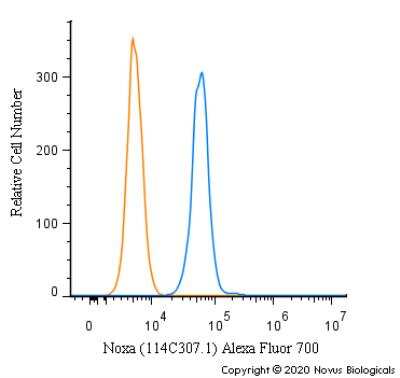Noxa Products
Noxa, phorbol-12-myristate-13-acetate-induced protein 1, PMA-induced protein 1, PMAIP1 (Human 6 kDa and Mouse 11.6 kDa) is a Bcl2 homology 3 (BH3) domain containing protein which plays a role in the regulation of apoptosis, specifically a pro-apoptotic role. Human Noxa contains only one BH3 domain, while the mouse and rat proteins contain two BH3 d...
Show More
47 results for "Noxa" in Products
47 results for "Noxa" in Products
Noxa Products
Noxa, phorbol-12-myristate-13-acetate-induced protein 1, PMA-induced protein 1, PMAIP1 (Human 6 kDa and Mouse 11.6 kDa) is a Bcl2 homology 3 (BH3) domain containing protein which plays a role in the regulation of apoptosis, specifically a pro-apoptotic role. Human Noxa contains only one BH3 domain, while the mouse and rat proteins contain two BH3 d...
Show More
Applications: IHC, WB, ICC/IF, Flow, KO
Reactivity:
Human,
Mouse,
Rat
| Reactivity: | Human, Mouse, Rat |
| Details: | Mouse IgG1 kappa Monoclonal Clone #114C307.1R |
| Applications: | IHC, WB, ICC/IF, Flow, KO |
Applications: IHC, WB, ICC/IF
Reactivity:
Human,
Mouse
| Reactivity: | Human, Mouse |
| Details: | Rabbit IgG Polyclonal |
| Applications: | IHC, WB, ICC/IF |
| Reactivity: | Mouse |
| Details: | Rat IgG2b Kappa Monoclonal Clone #69N15C9 |
| Applications: | WB |
| Applications: | WB, ELISA, MA, AP, PAGE |
Recombinant Monoclonal Antibody
| Reactivity: | Human |
| Details: | Rabbit IgG Monoclonal Clone #SR3425 |
| Applications: | WB |
Applications: IHC, WB, ICC/IF, Flow
Reactivity:
Human,
Mouse,
Rat
| Reactivity: | Human, Mouse, Rat |
| Details: | Mouse IgG1 kappa Monoclonal Clone #114C307.1 |
| Applications: | IHC, WB, ICC/IF, Flow |
Applications: IHC, WB, ICC/IF, Flow
Reactivity:
Human,
Mouse,
Rat
| Reactivity: | Human, Mouse, Rat |
| Details: | Mouse IgG1 kappa Monoclonal Clone #114C307.1 |
| Applications: | IHC, WB, ICC/IF, Flow |
Applications: IHC, WB, ICC/IF, Flow
Reactivity:
Human,
Mouse,
Rat
| Reactivity: | Human, Mouse, Rat |
| Details: | Mouse IgG1 kappa Monoclonal Clone #114C307.1 |
| Applications: | IHC, WB, ICC/IF, Flow |
Applications: IHC, WB, ICC/IF, Flow
Reactivity:
Human,
Mouse,
Rat
| Reactivity: | Human, Mouse, Rat |
| Details: | Mouse IgG1 kappa Monoclonal Clone #114C307.1 |
| Applications: | IHC, WB, ICC/IF, Flow |
| Reactivity: | Mouse |
| Details: | Rat IgG2b Kappa Monoclonal Clone #69N15C9 |
| Applications: | WB |
| Reactivity: | Mouse |
| Details: | Rat IgG2b Kappa Monoclonal Clone #69N15C9 |
| Applications: | WB |
Applications: IHC, WB, ELISA, ICC/IF
Reactivity:
Human,
Mouse,
Rat
| Reactivity: | Human, Mouse, Rat |
| Details: | Mouse IgG1 kappa Monoclonal Clone #114C307.1 |
| Applications: | IHC, WB, ELISA, ICC/IF |
Applications: IHC, WB, ICC/IF, Flow
Reactivity:
Human,
Mouse,
Rat
| Reactivity: | Human, Mouse, Rat |
| Details: | Mouse IgG1 kappa Monoclonal Clone #114C307.1 |
| Applications: | IHC, WB, ICC/IF, Flow |
| Reactivity: | Mouse |
| Details: | Rat IgG2b Kappa Monoclonal Clone #69N15C9 |
| Applications: | WB |
| Reactivity: | Mouse |
| Details: | Rat IgG2b Kappa Monoclonal Clone #69N15C9 |
| Applications: | WB |
Applications: IHC, WB, ICC/IF, Flow
Reactivity:
Human,
Mouse,
Rat
| Reactivity: | Human, Mouse, Rat |
| Details: | Mouse IgG1 kappa Monoclonal Clone #114C307.1 |
| Applications: | IHC, WB, ICC/IF, Flow |
Applications: IHC, WB, ICC/IF, Flow
Reactivity:
Human,
Mouse,
Rat
| Reactivity: | Human, Mouse, Rat |
| Details: | Mouse IgG1 kappa Monoclonal Clone #114C307.1 |
| Applications: | IHC, WB, ICC/IF, Flow |
Applications: IHC, WB, ICC/IF, Flow
Reactivity:
Human,
Mouse,
Rat
| Reactivity: | Human, Mouse, Rat |
| Details: | Mouse IgG1 kappa Monoclonal Clone #114C307.1 |
| Applications: | IHC, WB, ICC/IF, Flow |
Applications: IHC, WB, ICC/IF, Flow
Reactivity:
Human,
Mouse,
Rat
| Reactivity: | Human, Mouse, Rat |
| Details: | Mouse IgG1 kappa Monoclonal Clone #114C307.1 |
| Applications: | IHC, WB, ICC/IF, Flow |
Applications: IHC, WB, ICC/IF, Flow
Reactivity:
Human,
Mouse,
Rat
| Reactivity: | Human, Mouse, Rat |
| Details: | Mouse IgG1 kappa Monoclonal Clone #114C307.1 |
| Applications: | IHC, WB, ICC/IF, Flow |
| Reactivity: | Mouse |
| Details: | Rat IgG2b Kappa Monoclonal Clone #69N15C9 |
| Applications: | WB |
| Reactivity: | Mouse |
| Details: | Rat IgG2b Kappa Monoclonal Clone #69N15C9 |
| Applications: | WB |
| Reactivity: | Mouse |
| Details: | Rat IgG2b Kappa Monoclonal Clone #69N15C9 |
| Applications: | WB |
Applications: IHC, WB, ICC/IF, Flow
Reactivity:
Human,
Mouse,
Rat
| Reactivity: | Human, Mouse, Rat |
| Details: | Mouse IgG1 kappa Monoclonal Clone #114C307.1 |
| Applications: | IHC, WB, ICC/IF, Flow |
Applications: IHC, WB, ICC/IF, Flow
Reactivity:
Human,
Mouse,
Rat
| Reactivity: | Human, Mouse, Rat |
| Details: | Mouse IgG1 kappa Monoclonal Clone #114C307.1 |
| Applications: | IHC, WB, ICC/IF, Flow |

![Western Blot: Noxa Antibody (114C307.1R)BSA Free [NBP3-07012] Western Blot: Noxa Antibody (114C307.1R)BSA Free [NBP3-07012]](https://resources.bio-techne.com/images/products/Noxa-Antibody-114C307-1R-Western-Blot-NBP3-07012-img0003.jpg)
![Western Blot: Noxa Antibody [NB100-56368] Western Blot: Noxa Antibody [NB100-56368]](https://resources.bio-techne.com/images/products/Noxa-Antibody-Western-Blot-NB100-56368-img0002.jpg)
![Western Blot: Noxa Antibody (69N15C9) [NBP2-25251] Western Blot: Noxa Antibody (69N15C9) [NBP2-25251]](https://resources.bio-techne.com/images/products/Noxa-Antibody-69N15C9-Western-Blot-NBP2-25251-img0001.jpg)
![SDS-PAGE: Recombinant Human Noxa GST (N-Term) Protein [H00005366-P01] SDS-PAGE: Recombinant Human Noxa GST (N-Term) Protein [H00005366-P01]](https://resources.bio-techne.com/images/products/qc_test-H00005366-P01-1.jpg)
![Western Blot: Noxa Antibody (SR3425) [NBP3-27768] -](https://resources.bio-techne.com/images/products/nbp3-27768_rabbit-noxa-mab-sr3425-7520249391312.jpg)


![Noxa Antibody (114C307.1) [mFluor Violet 500 SE] - Noxa Antibody (114C307.1) [mFluor Violet 500 SE]](https://resources.bio-techne.com/images/products/nb600-1159mfv500_mouse-noxa-mab-114c307-1-mfluor-violet-500-se-5720231315536.png)
![Noxa Antibody (114C307.1) [mFluor Violet 610 SE] [NB600-1159MFV610] - Noxa Antibody (114C307.1) [mFluor Violet 610 SE]](https://resources.bio-techne.com/images/products/nb600-1159mfv610_mouse-noxa-mab-114c307-1-mfluor-violet-610-se-672023911933.png)
![Noxa Antibody (114C307.1) [Alexa Fluor® 350] [NB600-1159AF350] - Noxa Antibody (114C307.1) [Alexa Fluor® 350]](https://resources.bio-techne.com/images/products/nb600-1159af350_mouse-monoclonal-noxa-antibody-114c307-1-alexa-fluor-350-29820239311061.jpg)